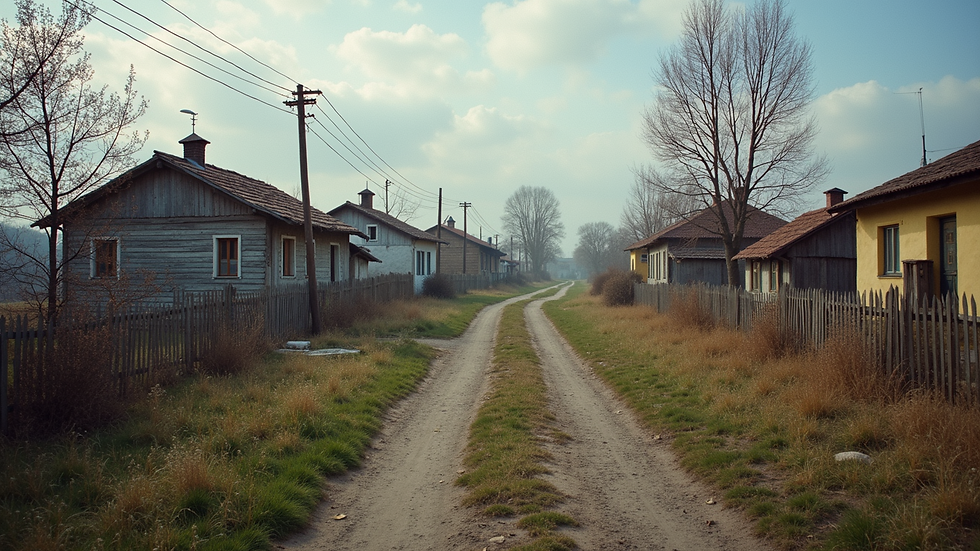Unveiling Ukraine's Ancient Roots How Slavic and Viking Influences Shape Modern Identity
- Becca

- Aug 21
- 4 min read
Updated: Nov 12
https://elenasalaks.medium.com/Fostering Stronger Communities Through SupportUkraine's history stretches far beyond its modern borders, with its land serving as a tapestry woven from diverse cultures and influences. From the 5th and 6th centuries CE, as Slavic tribes began to settle across the region, to the emergence of the Kyivan Rus under Viking prince Oleg in 882 CE, these ancient roots play a significant role in shaping contemporary Ukrainian identity.
Through exploration of these early civilizations, we uncover how their legacies continue to resonate today.
The Arrival of the Slavic Tribes
During the 5th and 6th centuries, Slavic tribes began to inhabit what is now Ukraine, flowing into the region and bringing with them their customs, language, and beliefs. These tribes were skilled farmers and traders, establishing a network of settlements that would lay the groundwork for future societies.
As they settled, they interacted with neighboring cultures, including the Byzantines and the nomadic tribes of the Eurasian steppes. Such exchanges enriched the Slavic cultural fabric, fostering a blend of practices that would eventually crystallize into a unique identity.
The language of these early Slavs also served as the basis for many contemporary Slavic languages spoken in Ukraine today, showcasing the strong ties between the past and the present.
The Dawn of Kyivan Rus
Fast forward to 882 CE, when a pivotal event marked Ukraine's entry into the annals of written history: the capture of Kyiv by the Viking prince Oleg. The establishment of Kyivan Rus transformed the region into a significant power in Eastern Europe.
Kyivan Rus thrived as a center of trade and cultural exchange, connecting the Viking world in the north with the Byzantine empire to the south. This flourishing trade not only allowed for the exchange of goods but also facilitated the spread of ideas, art, and religion.
Although the Vikings were often depicted as marauders, they were also brilliant navigators and merchants, contributing to the economic and cultural development of the lands they touched.

The Legacy of the Vikings
The Viking influence in Ukraine runs deeper than mere conquests. The norms, customs, and governance introduced by these Norsemen shaped the political landscape in which early Slavic society flourished.
Among their contributions were advancements in shipbuilding and navigation techniques, which facilitated trade throughout the rivers of Eastern Europe and beyond. The integration of Viking traditions into Slavic culture paved the way for a more organized society and legal systems, adapting and merging ideas from both cultures.
Additionally, the Vikings left a rich mythological legacy that still permeates cultural practices and storytelling traditions in Ukraine today. Folktales, legends, and even some modern interpretations of ancient stories bear traces of this Nordic influence.
Cultural Intertwining
As Slavic and Viking cultures began to intertwine, new social structures emerged, giving rise to a distinct identity that embraced both heritages. This blending is evident not only in political alliances but also in art, music, and even religion.
Christianity began to spread during this era as well, particularly after Prince Vladimir of Kyiv converted in 988 CE. The adoption of Christianity brought with it an influx of Byzantine art and architectural styles, creating a unique blend of Eastern and Western influences that can still be celebrated in Ukrainian churches today.
Cultural festivals and traditions rooted in these ancient practices continue to thrive, offering modern Ukrainians a glimpse of their historical past. From traditional folk music to ancient rituals, the echoes of these early societies remain alive in the modern cultural landscape.
Modern Ukrainian Identity
In contemporary Ukraine, the influences of both the Slavic tribes and the Vikings can be observed in various aspects of identity—national pride, social values, and even arts and crafts. Ukrainian nationalists often evoke the history of Kyivan Rus to foster a sense of unity and identity.
The symbols and traditions derived from ancient cultures are not just relics of the past; they continue to mold the psyche of modern Ukrainians. National celebrations, such as Kyiv Day and various local festivals, highlight this rich cultural heritage.
The imagery of ancient warriors, shields, and traditional clothing often makes appearances in modern art and performances, further reaffirming the connection between contemporary and ancient Ukraine.

Conclusion
The arrival of Slavic tribes and the Viking conquests laid the foundations for Ukraine's vibrant history, serving as a reference point for modern notions of identity and belonging. As Ukrainians today navigate the complexities of a globalized world, the cultural footprints left behind by their ancestors offer both a sense of pride and a means to connect with their historical narratives.
Understanding these ancient influences not only enriches the way we appreciate Ukraine's past, but it also illuminates the ongoing journey of its people as they strive to honor their heritage while looking forward to the future. In recognizing the interconnectedness of their history, modern Ukrainians continue to embrace their roots as they craft their unique identity on the global stage.





Comments